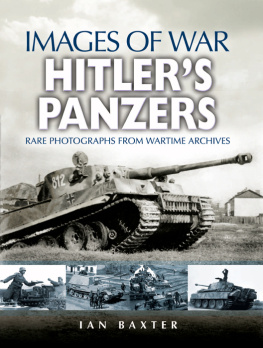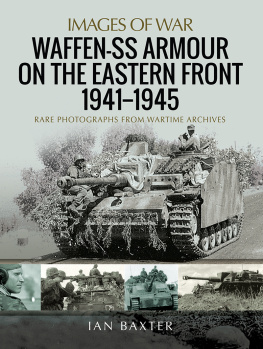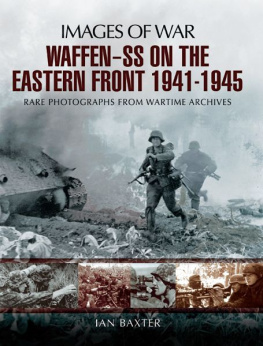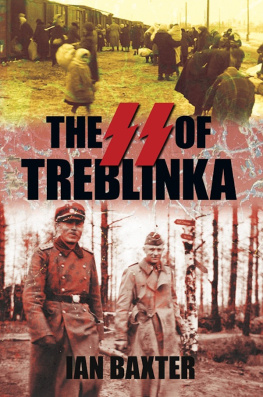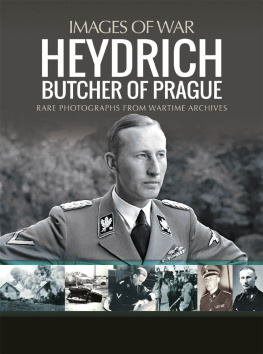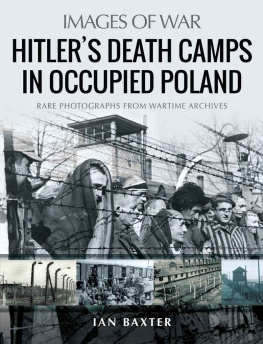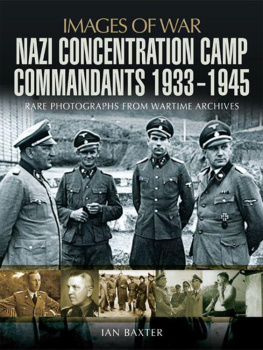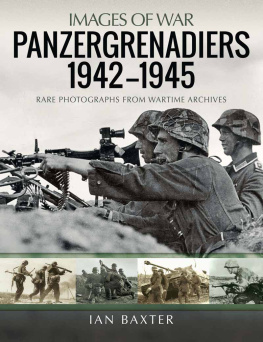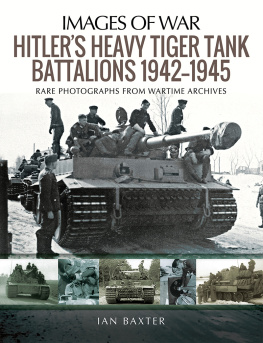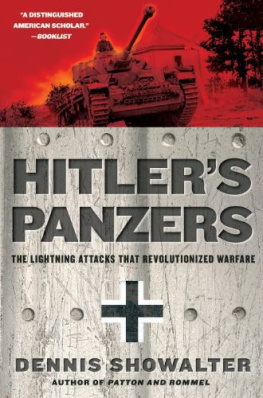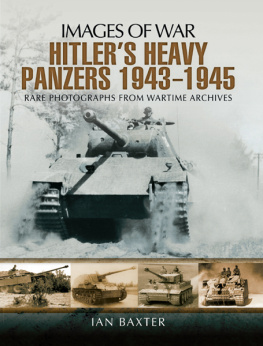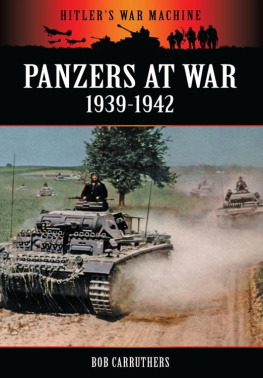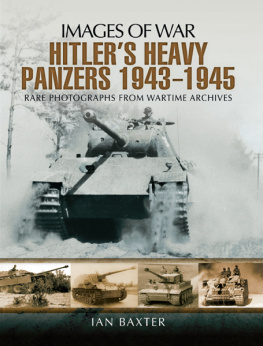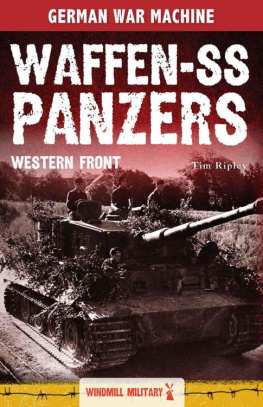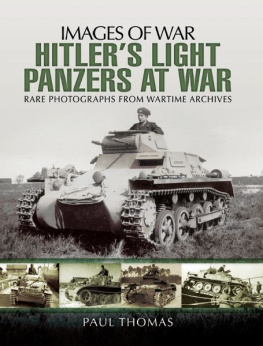Ian Baxter - Images of War: Hitlers Panzers
Here you can read online Ian Baxter - Images of War: Hitlers Panzers full text of the book (entire story) in english for free. Download pdf and epub, get meaning, cover and reviews about this ebook. year: 2007, publisher: Pen & Sword Military, genre: Non-fiction. Description of the work, (preface) as well as reviews are available. Best literature library LitArk.com created for fans of good reading and offers a wide selection of genres:
Romance novel
Science fiction
Adventure
Detective
Science
History
Home and family
Prose
Art
Politics
Computer
Non-fiction
Religion
Business
Children
Humor
Choose a favorite category and find really read worthwhile books. Enjoy immersion in the world of imagination, feel the emotions of the characters or learn something new for yourself, make an fascinating discovery.
- Book:Images of War: Hitlers Panzers
- Author:
- Publisher:Pen & Sword Military
- Genre:
- Year:2007
- Rating:5 / 5
- Favourites:Add to favourites
- Your mark:
- 100
- 1
- 2
- 3
- 4
- 5
Images of War: Hitlers Panzers: summary, description and annotation
We offer to read an annotation, description, summary or preface (depends on what the author of the book "Images of War: Hitlers Panzers" wrote himself). If you haven't found the necessary information about the book — write in the comments, we will try to find it.
Images of War: Hitlers Panzers — read online for free the complete book (whole text) full work
Below is the text of the book, divided by pages. System saving the place of the last page read, allows you to conveniently read the book "Images of War: Hitlers Panzers" online for free, without having to search again every time where you left off. Put a bookmark, and you can go to the page where you finished reading at any time.
Font size:
Interval:
Bookmark:

First published in Great Britain in 2006 by
PEN & SWORD MILITARY
an imprint of
Pen & Sword Books Ltd,
47 Church Street, Barnsley,
South Yorkshire.
S70 2AS
Copyright Ian Baxter, 2006
ISBN 1-84415-490-4
eISBN 978-1-84468-872-2
PRC ISBN 978-1-84468-873-9
The right of Ian Baxter to be identified as Author of this Work has been asserted by him in accordance with the Copyright, Designs and Patents Act 1988.
A CIP catalogue record for this book is available
from the British Library
All rights reserved. No part of this book may be reproduced or transmitted in any form or by any means, electronic or mechanical including photocopying, recording or by any information storage and retrieval system, without permission from the Publisher in writing.
Printed and bound in Great Britain by CPI UK
Pen & Sword Books Ltd incorporates the imprints of
Pen & Sword Aviation, Pen & Sword Maritime, Pen & Sword Military, Pen & Sword Select, Pen & Sword Military Classics, Leo Cooper, Wharncliffe Local History
For a complete list of Pen & Sword titles please contact:
PEN & SWORD BOOKS LIMITED
47 Church Street, Barnsley, South Yorkshire, S70 2AS, England.
E-mail:
Website: www.pen-and-sword.co.uk
It is with the greatest pleasure that I use this opportunity on concluding this book to thank those who helped make this volume possible. My expression of gratitude first goes to my friend and photographic collector Rolf Halfen. He has been an unfailing source, supplying me with the bulk of the Panzer collection from numerous private albums that have been shut away for many years. Rolf has searched and contacted numerous collectors across Germany. Some of them would not part with their prized Panzer photographs, which made finding the later variant models so much harder. Armoured vehicles like the Hummel, Hetzer 38(t),Wespe, Nashorn and the even rarer models like the Jagdpanther and Jagdtiger, were difficult to say the least to find unpublished. I had numerous researchers trying to locate these elusive vehicles, but it was Rolf once again that managed to find them in private photo collections in Germany.
Further a field in Poland I am also extremely grateful to Marcin Zboiska, my Eastern Front photographic specialist, who supplied me with a number of rare photographs that he obtained from a private photographic collector in the Ukraine. The images he found show a host of interesting various models including late variant Panzerkampfwagen.IV's, Panthers, and Tigers. I was even handed a unique batch of images showing armoured regiments of the Bulgarian Army, that show new Panzers being delivered from Germany to Bulgaria on direct orders from Hitler. Although the Bulgarian Panzers did not see combat on the Eastern Front against the Red Army, it is still a fascinating glimpse of how the vehicles were utilised for a specific anti-partisan role in the Balkans.
All other images in this book are credited to the HITM Archive.
Although it was the British that invented tank warfare, it was the Germans that mastered it. This book describes how the Panzer evolved and how new fighting vehicles gained sufficient mobility and firepower to spearhead the Nazi Blitzkrieg through Europe. From the early victorious campaigns in 1939 and 1940, to the last ditch defence in Germany in 1945, each chapter features rare and unseen Panzer photographs and analyses these vehicles that dominated Europe, North Africa and the vast wastelands of the Soviet Union.
The sole purpose of this book is to share unpublished photographs with the military historian and enthusiast alike that both have a fascination with German armoured warfare of World War Two. The majority of the photographs collected are from private collections and are a simple volume of amateur snap-shots taken by ordinary German soldiers or Panzer crews. The entire collection has been reproduced in high digital format resolution from the original image. The reader may find that some of the photographs are slightly blurred, discoloured, scratched, soiled with various dust particles or dirt. But what makes this unpublished collection unique is that all the images have been untouched. There has been no digital enhancement to the image or any cropping. What the reader sees is what the photographer saw through his lens the moment the cameras shutter captured a part of history. For this reason alone the photographs in this book are an invaluable source that illustrates the importance of the development, the success and the final destruction of Hitler's once vaunted armoured force.
In each chapter the photographs primarily illustrate the different variant model Panzers that were produced and saw action on the battlefield. Although some of the photographs are posed snap-shots of soldiers or tank crews with their armoured vehicles, the images still vividly portray a realism, which many press photographs failed to achieve. Most of the Panzers in this volume are photographed advancing to the front, paused during a brief break in the fighting, or simply under repair in one of the many workshops. There contains limited action images. Real action photographs were relatively a rare occurrence and seldom did a photographer risk his life armed with just a camera. The majority of the action photographs in circulation today were taken by press agencies, many of which can clearly be seen as staged propaganda pieces of photographic memorabilia. Although they provided the reader with a detailed testament to how these Panzers were used, appeared, and fought in combat, their glossy unblemished appearance seemed to take away the true grit of war from an actual soldiers point-of-view. What makes this book different is that the photographs portray the Panzer war from a soldiers perspective. The amateur photography captivates every aspect of the Panzer and the dedicated men who fought with them with such deadly effect. This book is undoubtedly a vivid and fully illustrated account of the development and deployment of Hitler's Panzer's seen through the lens of the soldiers that marched and fought with them.

A Pz.Kpfw.II Autumn of 1941 on the Eastern Front. This was one of the most popular vehicles seen during the early years of the war. However, by the time it entered Russia in the summer of 1941 it soon became apparent that it was no match against some of the heaviest Soviet armour.
Even during the 1920's it was apparent that, for the modern army, the consequences of entering soldiers onto a battle field without proper armoured support, would be suicidal. This of course is one reason Germany were not allowed a tank force under the Versailles Treaty. However, once Adolf Hitler came into power the conditions of the treaty were slowly usurped for his own military purposes of secret expansion. What followed in the early 1930's was a period of covert experimentation which led to the development of the tank. In total secrecy the Kleintraktor, the forerunner of the Panzerkampfwagen. I, was moved to the tank proving grounds at Kama where its design and all the technical aspects of the machine was put through a series of tests. At the same time the crews and officers received practical training in the use of tanks in battle. Although the training went well there was only a very limited number of machines available, and it was clearly insufficient as a tank force.
Next pageFont size:
Interval:
Bookmark:
Similar books «Images of War: Hitlers Panzers»
Look at similar books to Images of War: Hitlers Panzers. We have selected literature similar in name and meaning in the hope of providing readers with more options to find new, interesting, not yet read works.
Discussion, reviews of the book Images of War: Hitlers Panzers and just readers' own opinions. Leave your comments, write what you think about the work, its meaning or the main characters. Specify what exactly you liked and what you didn't like, and why you think so.

